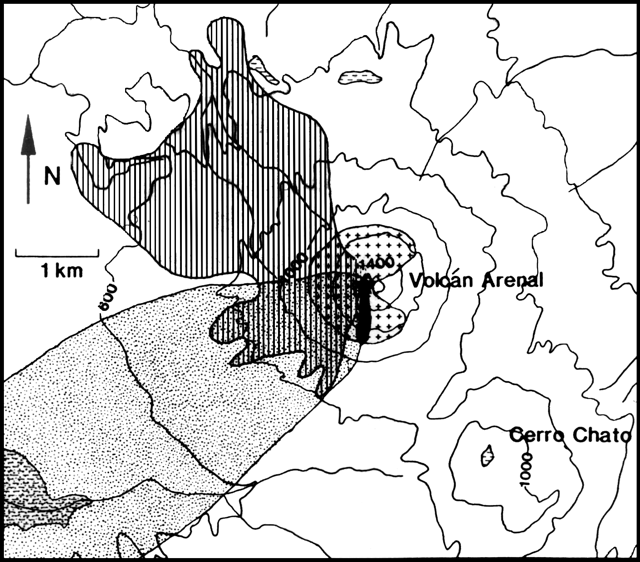Report on Arenal (Costa Rica) — July 1984
Scientific Event Alert Network Bulletin, vol. 9, no. 7 (July 1984)
Managing Editor: Lindsay McClelland.
Arenal (Costa Rica) Lava production slows as strong tephra ejection begins
Please cite this report as:
Global Volcanism Program, 1984. Report on Arenal (Costa Rica) (McClelland, L., ed.). Scientific Event Alert Network Bulletin, 9:7. Smithsonian Institution. https://doi.org/10.5479/si.GVP.SEAN198407-345033
Arenal
Costa Rica
10.463°N, 84.703°W; summit elev. 1670 m
All times are local (unless otherwise noted)
The following is from R. Van der Laat. "An increase in the activity of Arenal, in the form of eruptions of ash and large pyroclastics, was observed beginning the first week in June. A small increase in the crystallinity and quantity of silica in the lava, signs of a greater although low viscosity, may explain the increase in the intensity and frequency of eruptions of ash and bombs originating in the active crater. This coincides with a clear diminution in the movement of lava flow number 49 with an active front on 10-11 July at about 1,100 m elevation (400 m below the level of the active crater; figure 6). The frequency of the eruptions was approximately every 30 minutes. All emitted gases and about every fourth one produced ash and bombs accompanied by rumbling. The size of the ash eruptions was medium to small, reaching a mean maximum height of 800 m, and ashfall extended some 10 km W to SW of the active crater. The large pyroclastics did not reach farther than 1 km (on the flanks of the volcano, figure 6).
"Seismic data obtained in three visits to the volcano revealed a nearly total absence of volcanic earthquakes (other than seismicity accompanying the eruptions) but showed drastic changes in the eruptive character. Abundant on the seismograms were volcanic tremors and sonic waves that accompanied the eruptions of ash and bombs. Because bombs did not reach inhabited or farming-grazing areas and thanks to the great quantity of rain that continuously washes the ash, the risk at this time is minimal."
Strombolian activity was occurring during an 11-14 July visit to the volcano by Michael Carr. The following is from his report. "Explosions usually occurred erratically, but occasionally in a regular pattern with small explosions spaced at 10 ± 2-minute intervals. Weak explosions and 10-50-second periods of continuous pulsing gas emission occurred sporadically. Most of the explosions produced large blocks, which were red at night. Ashfall was intermittent and very light, even immediately downwind of the vent. A portable seismometer about 2.5 km from the crater, operated by Luis Diego Morales and Walter Montero of the Universidad Nacional, recorded B-type earthquakes during each explosion. The first seismic wave arrivals preceded the appearance of the eruption column by 2 seconds, indicating that the explosions originated at least 50 m below the crater rim. Until recently, lava flows were being nearly continuously produced from the crater, but the level of magma is now lower."
Geological Summary. Conical Volcán Arenal is the youngest stratovolcano in Costa Rica and one of its most active. The 1670-m-high andesitic volcano towers above the eastern shores of Lake Arenal, which has been enlarged by a hydroelectric project. Arenal lies along a volcanic chain that has migrated to the NW from the late-Pleistocene Los Perdidos lava domes through the Pleistocene-to-Holocene Chato volcano, which contains a 500-m-wide, lake-filled summit crater. The earliest known eruptions of Arenal took place about 7000 years ago, and it was active concurrently with Cerro Chato until the activity of Chato ended about 3500 years ago. Growth of Arenal has been characterized by periodic major explosive eruptions at several-hundred-year intervals and periods of lava effusion that armor the cone. An eruptive period that began with a major explosive eruption in 1968 ended in December 2010; continuous explosive activity accompanied by slow lava effusion and the occasional emission of pyroclastic flows characterized the eruption from vents at the summit and on the upper western flank.
Information Contacts: R. Van der Laat, Univ. Nacional, Heredia; M. Carr, Rutgers Univ.


